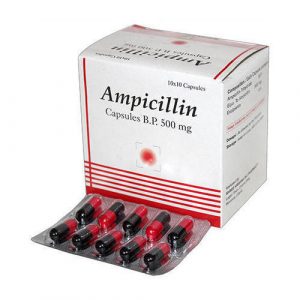There are five antibiotics that you should consider for your prepper pharmacy, to prepare for an emergency. As they say … it’s better to be safe, than sorry.
Many drugs stored under reasonable conditions retain 90% of their potency for at least 5 years after the expiration date on the label, and sometimes much longer. In the case of antibiotics, a 10-25% loss of potency over time may make little difference in treatment and could be made up for by higher dosing in serious infections
So just what antibiotics should you store? We have a list of the top 5 but do remember these are just suggestions and nothing here should be construed as medical advice. You should always talk to a medical professional before taking any sort of medicine.
Ampicillin
Ampicillin is a penicillin antibiotic used to prevent and treat a number of bacterial infections including ear infections, bladder infections, pneumonia, gonorrhea, E. coli, or salmonella.
- Ampicillin should be stored in a cold dark place as it is sensitive to light. Your storage temperatures should be around 40 degrees (or 4C).
Ampicillin is available under the following different brand names: Ampi, Omnipen, Penglobe, and Principen. General dosing guidelines for adults: Orally: 250-500 mg every 6 hours.
Chloramphenicol
Chloramphenicol is an antibiotic useful for the treatment of a number of bacterial infections. This includes use as an eye ointment to treat conjunctivitis. Chloramphenicol is mainly used to treat eye infections (such as conjunctivitis) and sometimes ear infections. By mouth or by injection into a vein, it is used to treat meningitis, plague, cholera, and typhoid fever.
The most serious adverse effect of chloramphenicol is bone marrow depression. Serious and fatal blood dyscrasias (aplastic anemia, hypoplastic anemia, thrombocytopenia, and granulocytopenia) are known to occur after the administration of chloramphenicol.
Kanamycin
Kanamycin A, often referred to simply as kanamycin, is an antibiotic used to treat severe bacterial infections and tuberculosis. It is not a first-line treatment. It is used by mouth, injection into a vein, or injection into a muscle. Kanamycin is recommended for short-term use only, usually from 7 to 10 days.
- Kanamycin should be stored in a cold dark place as it is sensitive to light. Your storage temperatures should be around 40 degrees (or 4C).
Kanamycin belongs to the class of medicines known as aminoglycoside antibiotics. It works by killing bacteria or preventing their growth.
Tetracycline
Tetracycline is used to treat infections caused by bacteria including pneumonia and other respiratory tract infections; certain infections of the skin, eye, lymphatic, intestinal, genital, and urinary systems; and certain other infections that are spread by ticks, lice, mites, and infected animals.
- Tetracycline should be stored in a cold dark place as it is sensitive to light. Your storage temperatures should be around 40 degrees (or 4C).
Tetracycline is an antibiotic used to treat many different bacterial infections, such as urinary tract infections, acne, gonorrhea, chlamydia, and others. Lying down right after taking tetracycline can cause esophagus irritation as well, so don’t take it immediately before going bed. Tetracycline is available under the following different brand names: Sumycin, Actisite, and Achromycin V.
Streptomycin
Streptomycin is used to treat moderate to severe bacterial infections in many different parts of the body. This includes tuberculosis, Mycobacterium avium complex, endocarditis, brucellosis, Burkholderia infection, plague, tularemia, and rat-bite fever.
- As with most antibiotics, Streptomycin should be stored in a cold dark place. Your storage temperatures should be around 40 degrees (or 4C).
Streptomycin is an aminoglycoside antibiotic that works by binding to the bacterial 30S ribosomal subunit, causing misreading of t-RNA, leaving the bacterium unable to synthesize proteins vital to its growth. Streptomycin is an effective antibiotic because its structure is similar to that of the anticodons that would usually bind to the ribosome. Streptomycin is significant because it was the first antibiotic that could treat tuberculosis. Over time, bacteria have become resistant to streptomycin.
Share this:
- Click to share on Facebook (Opens in new window)
- Click to share on Twitter (Opens in new window)
- Click to share on LinkedIn (Opens in new window)
- Click to share on Reddit (Opens in new window)
- Click to share on Tumblr (Opens in new window)
- Click to share on Pinterest (Opens in new window)
- Click to share on Pocket (Opens in new window)
- Click to share on Telegram (Opens in new window)
- Click to share on WhatsApp (Opens in new window)
- Click to print (Opens in new window)






